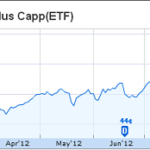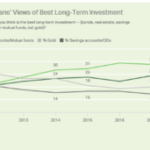ETF Investing holds many obvious benefits over individual stock-picking and several factors make ETFs Better Than Mutual Funds. However, this often lulls retail investors (and even institutional investors and professional money managers) into a false sense of complacency in that they think they’re entering into a particular type of investment or strategy and the results look dramatically different just a few weeks or months later versus expectations. If you’re going to take your investments seriously and focus purely on a) optimized gains per given risk tolerance, b) preservation of capital and/or c) adherence to or exceeding benchmark performance, you need to be keenly aware of the 7 Deadly Sins of ETF Investing:
1. Tracking Error – Tracking error can occur one of two ways. First, if an ETF purports to track say, the S&P500, but it holds a portion of its net holdings in cash, futures and other instruments, the actual performance of the ETF will never match that of the underlying index. Now, there are ample large pools of funds in large index ETFs to bring that tracking error down to what should be an acceptable level, like say, 0.1% over said given period of time. However, for more obscure indices where investor inflows/outflows, liquidity and other factors become more prominent, you may find that your investment does not match your objectives and you may be surprised to find out you didn’t earn what you thought you would. While this is a common complaint for mutual fund investors and somewhat so for ETF investors, it’s nowhere near as nefarious as the surprise you’ll see next…
2. Value Decay – While some might attribute this phenomena to “tracking error”, that is a false assertion. Tracking error is when your investment doesn’t do what it’s supposed to based on a benchmark. Value decay is when your shares lose money over time and you don’t understand why. Now you will. This can happen one of two ways. First off, many commodity ETFs and ETNs vastly underperform their benchmark because they rely on futures contracts which roll each month and value is lost each time. This was highlighted in more detail and by segment in the Worst ETFs of 2010 for ETNs like (VXX) and others.
Even worse is the value decay that occurs over time in leveraged ETFs. Due to the daily reset feature of some of the most popular 2X and 3X ETFs, as an underlying index pops up and down over time, the actual share price of the ETF slowly declines. Don’t believe me? The Financials ETF (XLF) is roughly flat on the year, at +.9% YTD. So, the 3X Financials ETF should be up at least marginally, right? OK, well let’s take off a bit for higher expenses and maybe it’s a wash? No, the 3X Financials ETF (FAS) is down 13% YTD. That’s a big shock to expectations for buy and hold ETF investors. This same phenomena plays itself out in every leveraged ETF – it is a mathematical certainty. The only exception is when a sustained up or down trend never breaks – which never happens (i.e. if an index ONLY moves up, the leveraged ETF will actually outperform its benchmark due to compounding, but when there’s volatility, net value is lost).
3. Trying to Time the Market – For some reasons highlighted earlier, some ETFs are ONLY useful for short periods of time. Anything on the order of weeks or months and you’re losing time value that you may not even be cognizant of. For that reason, you’re stuck as a market time in ETNs like (VXX) and leveraged ETFs. At least with stocks you can either trade OR buy and hold. If the fundamentals change, market conditions change or you want to take profits, you can exit that position. With some ETFs, you should ONLY be in it for a trade which is market timing, subjecting you to high commissions, tax liabilities an trying to beat professionals that have an edge on you in both experience, execution and information.
4. High Fees – Some ETFs and ETNs have surprisingly high expense rations. While actively managed mutual funds used to be faulted for their loads, 12b-1 fees and overall expenses often approaching 2%, there are plenty of ETFs well north of 1% as well. When considering the fact that over long periods of time, equities have returned 8-10% (depending on which study and timeframe), losing an additional 1% of your portfolio means you’re sacrificing over 10% of your total returns each year to expenses – and that’s on top of whatever commissions you’re paying. In some cases, to execute a particular strategy or get exposure to an asset when there’s no other way, you’ve gotta take on that downside. For instance, a niche actively managed ETF PowerShares Active AlphaQ carries an expense ratio of 0.75% but it’s beating (SPY) by over 4% on the year, so the extra expense is well worth it. But when there are perfectly acceptable alternatives or no proven benefit these additional expenses have serious consequences.
5. Trendy/Niche Strategies – Retail investors are drawn to a hot trend like moths to a flame. As the blogs, Cramer and others start to highlight a winning strategy, often times, the smart money is just beginning to sell, the fast traders just started getting in and retail investors are thinking about it. The, boom – a new ETF is launched with much fanfare or even a once obscure ETF starts to attract massive inflows. We may have just seen that with the once “hidden gem” of investing in the new MLP ETF which launched to great fanfare and interest given the incredibly attractive facets of Master Limited Partnerships, yet it has underperformed the broad market indices since launch. Then, there are ETFs, often for commodities, that you would have never even imaged. There’s a lumber ETF that was up 62% last year, but should you be investing in lumber stocks? Maybe, if your small business is hedging against lumber prices or something to that effect. But if I look back a year further at 2008, the lumber ETF greatly underperformed the S&P500 (little appetite for wood when there’s no new houses to be built). Before jumping on the next hot ETF trend, ask yourself if it fits your strategy, why you’re investing and whether this is a bubble. When you hear your co-workers talking about how they’re jumping into bond funds, just like they were talking oil in 2007 and internet stocks in 1999, that may very well signal a bubble.
6. Counterparty/Solvency Risk – Investors often assume ETNs (exchange traded notes) are the same as ETFs, but they’re not. One key difference is that an ETF holds the underlying stocks, futures, commodity (not always, but often) or asset being tracked. ETNs on the other hand use an issuing party to hold the “note” which means if they declare bankruptcy, which many firms either did or were on the brink in 2008-2009, holders of those ETNs such as typical retail investors may be left holding the bag, meaning their investments are either worthless or they’ll get pennies on the dollar, depending on what happens in bankruptcy proceedings. While the threat of insolvency for major financial firms is much lower now than it was during the financial collapse, there’s no telling what’s going to happen a few months out.
7. High Bid/Ask Spread – There are some very thinly traded ETFs and even more-so, in the ETN world, where there are so few shares traded that the buyer takes a haircut, as does the seller due to a very wide bid/ask spread. For instance, if you take a high volume ETF, like (SPY), the S&P500 proxy, there are millions of shares traded daily and the bid/ask at any given time is generally 1 cent or so. As such, you’re pretty much paying the same thing the guy on the other end is selling for. Well, with thinly traded instruments (stocks included), there are so few willing buyers and sellers at a given price, that the bids and the asks are relatively far apart, in some cases being 5-10% apart. If this is the case, and you’re already given up say, 1-2% on commission expenses, do you reasonably expect this investment to outperform your other opportunities by up to 12% for it to even make sense? Surely, there’s either a better opportunity somewhere else or you better intend on holding this thing for years to make up the difference (assuming it beats more conventional options anyway).
Disclosure: Author holds the following positions in aforementioned ETFs: Short FAS, Put position on SPY. For full context and holdings, see latest portfolio update.











{ 1 comment… read it below or add one }
I would be curious as to your take on various brokerage providers. It would seem that an account at a place like Vanguard would go a long way to mitigating some of these problems, such as the fees and bid/ask spread issues (they offer their in-family ETFs at cost, with very miniscule maintenance fees).
I found your section about tracking error and value decay to be valuable. I haven’t seen this information elsewhere in an easily-understandable format, so thank you for that.
{ 4 trackbacks }